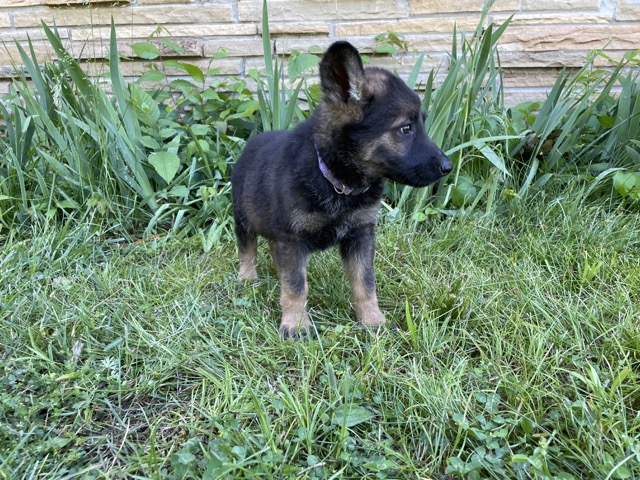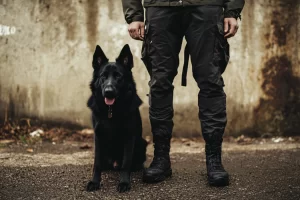The Root Cause of Your German Shepherd Puppies Biting Behavior
To the end of understanding and addressing the most common reasons why German Shepherd puppies exhibit bad biting behavior. To do so is vital to unpack the reasons for this behavior. First, we’ll seek to understand why your German Shepherd puppies are behaves this way, then we’ll come up with a plan to solve this behavior.
The Developmental Stages of German Shepherd Puppies
At around 4 weeks of age, puppies transition into a phase where they engage in playful interactions with their littermates. This play revolves around physical activities like pushing each other around and playfully biting. The dynamics in these interactions resemble games that mimic hunting behavior, with elements of chasing and playful encounters prevalent.
Upon transitioning to a human-centric environment, there is a transitional period of approximately a week during which puppies acclimate to perceiving their human family members as their new pack mates.
During this adjustment phase, it is common for puppies to mirror the behaviors they exhibited with their littermates. Hence, they may resort to biting, chewing on family members, and engaging in playful chasing activities with humans, replicating behaviors from their previous social dynamics. Notably, these biting tendencies in puppies do not stem from aggression but rather from ingrained habits associated with pack play.
Considering this perspective, it becomes evident that expecting puppies to act differently upon entering a human environment is impractical, given that their interactions with littermates have shaped their behavior since birth.
The Role of Prey Drive in German Shepherd Puppies Bad Biting Behavior
A fundamental aspect that influences a dog’s behavior is its prey drive, which denotes the innate genetic instinct dictating a dog’s inclination to chase after targets. Dogs exhibit varied levels of prey drive, with some showcasing a heightened interest in chasing balls, toys, children, and even pant legs.
Distinguishing between behaviors driven by prey instincts and those rooted in aggression is paramount. Activities such as chasing balls, chasing sticks, or nipping at pant legs typically stem from prey drive, emphasizing the dog’s inherent inclination for playfulness rather than hostility. Conversely, aggressive behaviors, like attempting to bite when cornered, often arise from fear-based responses or other underlying factors.
Educating Your German Shepherd Puppies on Appropriate Behavior
The pivotal responsibility lies with humans to educate puppies on adapting to cohabiting with their new human pack members. Nonetheless, challenges often arise for pet owners as puppies perceive play with humans as an extension of their interactions with littermates, while humans may misinterpret these actions as aggression.
Effective Strategies for Handling Puppy Biting
Given the inherent sharpness of puppy teeth and their potential to cause discomfort and injury, guiding German Shepherd puppies towards curbing their biting impulses is imperative. Implementing the following methods can aid in redirecting and reshaping a puppy’s behavior:
Method 1: Communicating Boundaries
Mirroring the natural cue employed by littermates, emitting a high-pitched sound akin to a yelp upon experiencing a painful bite can convey to the puppy that the action was excessive. This method serves as a symbolic way to communicate that biting excessively is unacceptable. Subsequently, offering positive reinforcement in the form of gentle praise and rewards can reinforce desirable behaviors.
Method 2: Redirecting Behavior with Toys
Utilizing toys as a diversionary tactic can effectively steer a puppy’s attention away from biting humans towards engaging with designated play objects. Having an array of soft toys readily available during interactions with the puppy can facilitate seamless redirection, thereby fostering a positive association with these toys as alternatives to biting.
Encouraging Physical Exercise and Mental Stimulation
Regular exercise routines and mental stimulation are crucial components of a puppy’s development. Engaging puppies in activities that cater to their physical and mental well-being, such as scheduled walks and mentally stimulating tasks, can help channel their energy positively and minimize instances of biting due to excess energy.
Six Additional Strategies for Redirecting German Shepherd Puppies Biting
1. Interactive Play with Toys: Encourage interactive play sessions with suitable toys to redirect your puppy’s biting impulses. Offer a variety of chew toys, ropes, or interactive puzzle toys to keep your puppy engaged and focused on appropriate items to nibble on. By providing engaging alternatives, you can steer your puppy away from unwanted biting behaviors towards more constructive play.
2. Positive Reinforcement: Utilize positive reinforcement techniques to reward desired behaviors and discourage biting. When your German Shepherd puppies refrain from biting or redirects its attention to toys, offer verbal praise, gentle petting, or small treats as a form of positive reinforcement. Consistent praise and rewards help reinforce the message that non-biting actions are encouraged and rewarded.
3. Training and Socialization: Invest time and effort in obedience training and socialization exercises to instill discipline and good behavior in your German Shepherd puppy. Enroll your puppy in puppy training classes or seek guidance from professional trainers to address biting issues through structured training sessions. Socializing your puppy with other dogs and people can also help in reducing biting tendencies by fostering positive interactions.
4. Avoid Rough Play: Refrain from engaging in rough play with your puppy, as this can inadvertently encourage biting behavior. Discourage behaviors like using hands or fingers as playthings, as this may confuse your puppy about acceptable play boundaries. Instead, opt for gentle interactions and controlled play sessions to maintain a safe and positive environment for your puppy.
5. Time-Out Approach: Implement a time-out approach to teach your puppy that biting leads to the end of playtime. If your puppy becomes too rough or starts biting, calmly remove yourself from the interaction or place your puppy in a designated time-out area for a brief period. This method conveys the message that biting results in the cessation of enjoyable activities, helping your puppy understand the consequences of its actions.
6. Consistent Boundaries and Rules: Establish clear boundaries and consistent rules regarding biting behavior to set expectations for your German Shepherd puppies. Be firm and consistent in discouraging biting, and ensure that all family members or household occupants follow the same guidelines. By maintaining a unified approach to addressing biting behavior, you can reinforce a predictable and structured environment that promotes positive behavior.
Incorporating a combination of these strategies can help pet owners effectively manage and redirect biting behavior in puppies. Remember that patience, consistency, and positive reinforcement are key components in reshaping your puppy’s behavior. With dedication and proactive intervention, pet owners can successfully address biting issues and foster a harmonious relationship with their furry companions.
Conclusion
At Czech Working Line we recommend that adopting a balanced approach that blends communication, redirection, exercise, and mental engagement, pet owners can navigate puppy biting behaviors effectively, nurturing healthy bonds and conducive environments for their furry companions’ growth and well-being.




